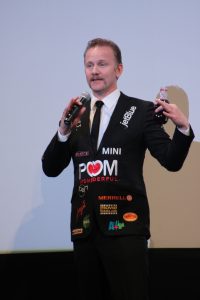Date Posted: May 18, 2011
Print Edition: May 13, 2011
By Sophie Isbister (The Cascade) – Email
 Morgan Spurlock has done it again, and this time his documentary film The Greatest Movie Ever Sold managed to stay away from the sanctimonious preaching characterized by his first effort Supersize Me.
Morgan Spurlock has done it again, and this time his documentary film The Greatest Movie Ever Sold managed to stay away from the sanctimonious preaching characterized by his first effort Supersize Me.
Self referential to the point of meta, The Greatest Movie Ever Sold is the chronicle of Spurlock shopping his movie around for corporate sponsorship. Interspersed with his attempts to get funding from thousands of famous brands are interviews with people in media, film, and advertising. His goal was to have the entire 1.5 million budget of the film completely funded by product placement and co-promotion with a number of sponsors. The entire project is necessarily transparent, so I assure you it is not a spoiler for me to say that he succeeded in his quest.
The film is predicated on something that we all know. Hollywood blockbusters are notorious for “selling out” – or is it “buying in?” The movie tacitly accepts product placement as a reality: few interviewees decry branding in films. In fact, filmmakers seem to view it was a symbiotic relationship. Advertisers want placement in films and films need products. A segment interviewing Quentin Tarantino showed the eccentric director lamenting the fact that Denny’s never let him film scenes from Pulp Fiction and Reservoir Dogs inside their restaurants.
The movie focuses strongly on the idea of a personal brand: an early scene shows Spurlock going to an image consultant to determine his own personal brand. The idea of personal brand and image for public figures is featured prominently in a later interview with Donald Trump: after the interview, a pullaway shot shows a peek of the professional lighting setup in Trump’s board room. After all, Trump himself is a brand which relies on good optics and luxury. Spurlock’s brand is a mixture of “mindfulness” and “playfulness,” a conclusion that the marketing firm Olson Zaltman discovered about him in their grueling questioning process, all of which, of course, was documented in the film.
The Greatest Movie Ever Sold is insightful – to a point. More than that, it’s hilarious. It touches on a topic we are all familiar with. Anyone who has seen Heroes surely remembers Hayden Panettiere’s character receiving a Nissan Rogue as a gift, a car which, in every subsequent scene, is referred to as “the Nissan Rogue” and not “the car” – which is how most people would refer to it. Most people in the film agreed that such egregious product placement goes a little too far, but the overwhelming feeling was that brands have become a normal part of the movie “business.”
The real treat in the movie is seeing the inner workings of Spurlock’s ad pitches, his frequent visits to stuffy boardrooms, and the thousands of cold calls he made before he found his final sponsors (which included Old Navy, Ban, Pom, Wonderful, and Amy’s Natural Foods among a dozen or so others). Spurlock also visits a firm that measures your brain waves while you watch ads to tell which ads are the most effective based on the emotional response they create in your brain. He goes to Sau Paulo, Brazil, where they have banned all outdoor advertisements, and he speaks to citizens and business owners alike to see how the ban has affected them (there were no complaints).
The movie follows the creation of the movie, from the pitch, getting sponsors, negotiating the labyrinthine contracts involved, and finishes by chronicling the marketing stage and all the co-promotion with his sponsors that followed. The film is laugh-out-loud funny and more than a little bit informative. But the most important part is that it doesn’t preach. Spurlock uses his documentarian’s tools simply to bring these ideas to people’s minds. He doesn’t take a stance – except once. Spurlock remarks, “I feel like I’m going to lose control of what’s going on in the movie.” And I’m sure he’s not the only filmmaker to ever think that. Perhaps that’s the real question that he wants to bring to our minds, without specifically answering it for us either way: can corporatism be inherent in art?


